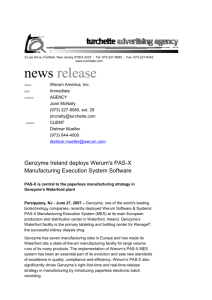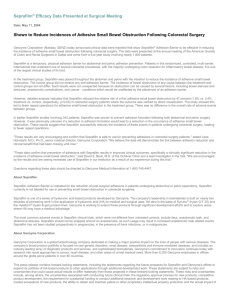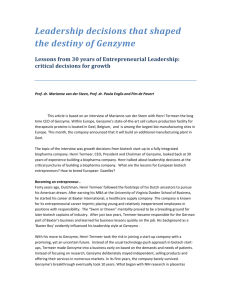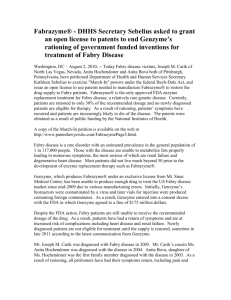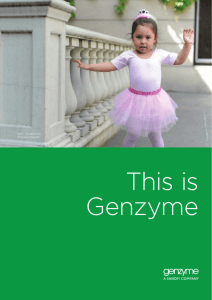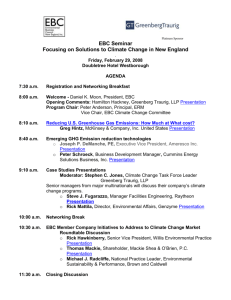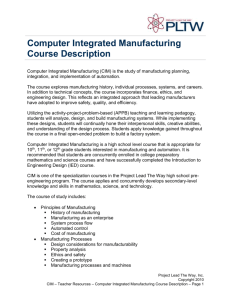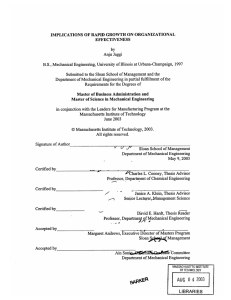Class 13: Apr. 5 Genzyme Case
advertisement
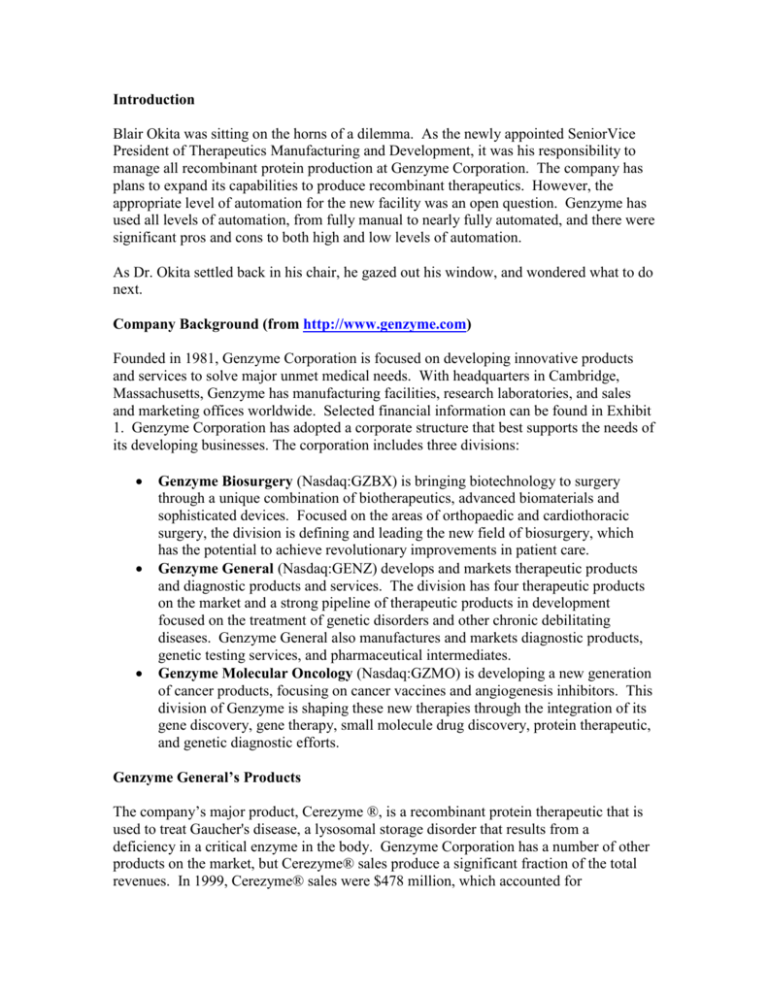
Introduction Blair Okita was sitting on the horns of a dilemma. As the newly appointed SeniorVice President of Therapeutics Manufacturing and Development, it was his responsibility to manage all recombinant protein production at Genzyme Corporation. The company has plans to expand its capabilities to produce recombinant therapeutics. However, the appropriate level of automation for the new facility was an open question. Genzyme has used all levels of automation, from fully manual to nearly fully automated, and there were significant pros and cons to both high and low levels of automation. As Dr. Okita settled back in his chair, he gazed out his window, and wondered what to do next. Company Background (from http://www.genzyme.com) Founded in 1981, Genzyme Corporation is focused on developing innovative products and services to solve major unmet medical needs. With headquarters in Cambridge, Massachusetts, Genzyme has manufacturing facilities, research laboratories, and sales and marketing offices worldwide. Selected financial information can be found in Exhibit 1. Genzyme Corporation has adopted a corporate structure that best supports the needs of its developing businesses. The corporation includes three divisions: Genzyme Biosurgery (Nasdaq:GZBX) is bringing biotechnology to surgery through a unique combination of biotherapeutics, advanced biomaterials and sophisticated devices. Focused on the areas of orthopaedic and cardiothoracic surgery, the division is defining and leading the new field of biosurgery, which has the potential to achieve revolutionary improvements in patient care. Genzyme General (Nasdaq:GENZ) develops and markets therapeutic products and diagnostic products and services. The division has four therapeutic products on the market and a strong pipeline of therapeutic products in development focused on the treatment of genetic disorders and other chronic debilitating diseases. Genzyme General also manufactures and markets diagnostic products, genetic testing services, and pharmaceutical intermediates. Genzyme Molecular Oncology (Nasdaq:GZMO) is developing a new generation of cancer products, focusing on cancer vaccines and angiogenesis inhibitors. This division of Genzyme is shaping these new therapies through the integration of its gene discovery, gene therapy, small molecule drug discovery, protein therapeutic, and genetic diagnostic efforts. Genzyme General’s Products The company’s major product, Cerezyme ®, is a recombinant protein therapeutic that is used to treat Gaucher's disease, a lysosomal storage disorder that results from a deficiency in a critical enzyme in the body. Genzyme Corporation has a number of other products on the market, but Cerezyme® sales produce a significant fraction of the total revenues. In 1999, Cerezyme® sales were $478 million, which accounted for approximately 84% of the total product revenue (Genzyme General 1999 Annual Report). Genzyme is currently pursuing additional recombinant protein therapeutics, and has a strong product pipeline, which, according to the 1999 Annual Report, includes 6 drug candidates in Phase III clinical trials, and an equal number in preclinical development. Thyrogen® (thyrotropin alfa for injection) is a synthetic source of thyroid stimulating hormone (TSH) developed for use in thyroid cancer patients who have had partial or total removal of their thyroid gland, and who therefore must take thyroid hormone supplements and undergo periodic testing for metastatic cancer. Prior to the availability of Thyrogen®, some tests required patients to stop taking their hormone supplements for two to six weeks prior to testing. This thyroid hormone withdrawal raises the level of another hormone - TSH - in the patient's bloodstream so that metastases or other recurrences can be detected with radioiodine scanning. Hormone withdrawal causes hypothyroidism. These symptoms include fatigue, weight gain, constipation, mental dullness, lethargy, depression and other adverse reactions. Thyrogen® allows patients to stay on their thyroid hormone supplement throughout the course of the periodic testing. Additionally, Genzyme has just acquired, GelTex Pharmaceuticals, based out of Waltham, MA. GelTex has two major products, the first, WelCholTM, is a cholesterol lowering agent. The second is Renagel ®, which is used to treat hyperphosphatemia in patients on dialysis. Hyperphosphatemia is when serum phosphorus levels are increased in the patient’s body. Before the purchase was announced, GelTex and Genzyme were in a 50/50 partnership for the manufacture and sales of Renagel®. Genzyme has built a plant in the United Kingdom to produce the active ingredient in Renagel®. “The number of patients undergoing dialysis for end-stage renal disease is estimated to be 280,000 in the US and 170,000 in Europe. These numbers are increasing by 7-8 percent annually.” (Genzyme press release, July 13, 2000) The Pipeline Exhibit 2 gives an outline of the products in development. The products that are closest to market are FabrazymeTM and AldurazymeTM. FabrazymeTM is a treatment for Fabry Disease, which is caused by a deficiency of the enzyme alpha-galactosidase. Due to organ complications, death typically occurs around age 40 for the estimated 2,000-4,000 people worldwide afflicted with the disorder. Fabrazyme is a recombinant form of alpha-galactosidase designed to replace the deficient enzyme and prevent the lipid accumulation that leads to the devastating symptoms of Fabry disease. Following FDA approval, Genzyme plans to launch Fabrazyme immediately in the United States. Aldurazyme™ (recombinant human a-L-iduronidase) is an enzyme replacement therapy for patients with mucopolysaccharidosis I (MPS-I). Findings reported in the New England Journal of Medicine suggest that Aldurazyme has potential to alleviate the primary symptoms of MPS-I, a life-threatening genetic disorder that affects young children and for which there currently is no known adequate treatment. (Genzyme press release, 1/18/2001) In 1998, BioMarin and Genzyme formed BioMarin/Genzyme LLC to develop and commercialize Aldurazyme throughout the world. BioMarin and Genzyme have received Orphan Drug designation and Fast-Track status for Aldurazyme from the U.S. Food and Drug Administration, as well as a positive opinion on orphan designation from the European Agency for the Evaluation of Medicinal Products. Therapeutics Production at Genzyme Most of Genzyme’s facilities are located throughout eastern Massachusetts. The following lists the various locations and the major functions performed at each site. Framingham – The Framingham campus has continued to expand over the last 10 years. It currently consists of 11 buildings, which include labs, offices, manufacturing, pilot plants, and an animal facility. Framingham is currently the largest site for Genzyme, e. The most important sites in Framingham include 51 NYA (a development and manufacturing site), 74, 76, 78, and 80 NYA (manufacturing, lab space, pilot plants), 1 and 5 Mtn Rd. (labs), and MetroWest (admin, management, finance, materials management, etc.) Thyrogen is currently produced at 51 NYA. This facility is also licensed to produce other products. The facility has a number of small fermentation tanks. Purification is accomplished using portable skid mounted equipment. The facility does not have much automation, and is run mostly manually, although there are some systems for data logging and alarming. There are a great number of single loop controllers to run the bioreactors, and there are many PC’s used for SCADA (Supervisory Control and Data Acquisition). The facility has just put in the most state of the art system found at Genzyme to control two new pilot scale reactors. These systems were not yet in use at the time of this writing. Allston – The Allston Landing Facility is the main manufacturing facility for Cerezyme. It produces a majority of the revenues for Genzyme, and yet is one of the smallest sites in terms of head count. This site is staffed with manufacturing and manufacturing support (QA, QC, facilities, etc.) personnel. The facility is highly automated, a Distributed Control System (DCS), manages and monitors all aspects of production. There are four 2000 L tanks that are used for cell culture. There are several temperature controlled rooms that are used for purification, with portable skid mounted equipment. Binney St. – Genzyme’s oldest plant. It used to be the manufacturing site for Ceridase (the precursor to Cerezyme). It now makes HA and some molecules that are used for Cerezyme processing. This plant is almost entirely manual. There are no computers in use on the plant floor. What little automated control there is (a handful of temperature control loops for reactors) is achieved using Single Loop Controllers. Haverhill, England – Genzyme’s newest plant. The original facility here made enzymes, but has been torn down to make room for a brand new facility. This plant has a moderate to high level of automation, and makes the active ingredient for Renagel. It uses PLC’s to monitor and control critical tasks. However, operators have significant responsibilities on the plant floor, and are required to leave the control room on a regular basis to perform certain tasks. This plant is slightly different than Genzyme’s other facilities, in that the product made here is chemical (not biological) in nature, and the process is run continuously. About 10% of the total facility cost has been spent on automation. Fall River – Genzyme’s surgical products are manufactured in Fall River. This site houses all of the functions for that business, including management, manufacturing, marketing, sales, etc. Kendall – The Kendall Square location has a mix of corporate people (marketing, program management, legal, HR, etc.) and scientific staff. There are labs and offices spread throughout buildings at One Kendall Square in Cambridge, MA. Other sites – Genzyme also has facilities in GA, CT, CA, and various genetic testing support centers all over the US. Automation Technology DCS Generally the DCS is a large central processing unit (or units) installed in a central control room, with operator and engineering interfaces in the control room and on the plant floor. The hardware and software has traditionally been proprietary, specific to an individual vendor. DCS systems have traditionally been the largest and most expensive control systems used. The Allston Landing Facility uses a Fisher Rosemount RS3 DCS system. This system is also tied into a large number of other systems, including PLC’s for specific pieces of equipment, a data logging system, and many other analysis, alarming, and reporting tools. PLC PLC’s, were a result of the need for additional control functionality in a smaller and less costly system than the DCS’s were able to provide. PLC’s generally have less capability than a full-fledged DCS, but are usually less expensive. Some of the other advantages to PLC control are listed by Parr (1998) as standard parts, ease of upgrading (having spare capacity), ability to pre-build and test subsections of the control system, and ease of access to data and programming. These advantages are also found in DCS and PC based systems as well. PC Nearly everyone is now familiar with Personal Computers in their capacity as tools in homes and offices around the world. However, a less well-known use of the PC is to use it for industrial control. PC’s have some advantages over the DCS and PLC systems that have been discussed above. PC’s are commonly available from a multitude of vendors. Nearly every engineer has some degree of experience working with and programming on PC’s. They are also extremely inexpensive compared to the other options. However, on the other hand, PC’s are not necessarily designed for use in industrial environments. Unless one buys a special industrial PC, it is susceptible to dust and dirt, and must be kept either in a special enclosure or sometimes removed from the plant floor entirely. Further, PC’s generally do not have the capability to be connected to field instrumentation and control devices without special hardware and software. Currently the most common use of PC’s in industrial control is to use them in conjunction with PLC’s, Single Loop Controllers, and/or DCS’s. They are most commonly used as HMI’s (Human Machine Interface), allowing the operators and engineers a simple and customizable interface to the other control hardware. The PC is used as a display terminal, showing custom designed graphics which represent the control functions that are being carried out by the other hardware and software. Operators can interact with the graphics shown on the PC and use that interface to actuate valves, monitor plant conditions, and generally interact with the control systems. Engineers frequently use PC’s as a programming interface for the control systems. SINGLE LOOP CONTROLERS Single Loop Controllers are the simplest and least expensive of all control the control technology listed above. They are used to implement PID control when no other programming or communication is required. Most single loop controllers will run one to eight control loops, with the capability to alarm at a high value and a low value. Some have rudimentary data logging capabilities. These devices are used primarily when there is a need for a control loop, but no need for an interface with other parts of the plant or process. An example would be an isolated reactor that requires temperature control. There is no need for any other part of the plant to be informed of the temperature of that reactor, and the PID control in the single loop controller will be more than adequate to control the temperature in the reactor. If the temperature is too high or too low, the controller can signal an alarm to make an operator aware of the problem. Therapeutics Manufacturing Technology The process is generally divided into two parts, upstream and downstream. Upstream processing consists of cellular growth and production of products. It also includes the removal of the desired product (and impurities) from the cellular mass. Downstream processing is all of the purification activities that are required to remove impurities and deliver the final bulk active product. Upstream Almost all recombinant therapeutic products are proteins. Proteins are produced by cells based on the genetic code stored in DNA. It is possible to insert a desired DNA sequence into a cell, and have the normal cellular machinery make that protein. The cells that have been transfected with the desired DNA are made in a laboratory and are frozen in what is called a Master Cell Bank (MCB). Cells are taken from the MCB and used to create a Working Cell Bank (WCB). The WCB is kept frozen, and cells are taken from it to start each batch of product. When the WCB is depleted a new WCB is created from the MCB. This process is done very infrequently (generally only a few times per year). On a more regular basis, cells from the WCB are thawed and put into small reactors (less than 1 L), usually in a lab setting. These cells are then given nutrients and allowed to multiply until the cell density is such that they can be transferred to a larger reactor. This process is repeated as many times as necessary to have enough cells to inoculate the full size reactor. This process can take anywhere from a few days to a month or two, depending on the sizes of the tanks, and the growth rates of the cells. Mammalian cells double every 24 to 36 hours, where bacterial cells can double every 20 minutes. For mammalian cells the initial vial taken from the WCB is contains about 1 million cells and has a volume of approximately 1 mL. The final tank is usually on the order of 2000L and the inoculum to that tank should make the initial cell density approximately 105 cells/L. Once the desired cell density is reached in the main reactor(s), the cells will produce the product of interest. This reactor is always temperature controlled, and has facilities for monitoring and/or controlling pH, dissolved oxygen concentration, volume, etc. There are three major methods used for running bioreactors. - Batch - The cells are grown from the initial inoculum density to some final density. Then the entire contents of the reactor are collected and purified. The process then begins again from the WCB stage. - SemiBatch - Also known as "feed and bleed". This process takes the initial inoculum concentration and allows the cell density to increase for some set period of time or until some maximum density is reached (usually a few days for mammalian cells). Then some fraction of the tank is taken for purification (usually about 75 to 85%). Fresh nutrient solution is added to the material that remains in the tank (which contains cells, product, nutrients, by-products, etc.) such that the density of the cells is approximately that of the initial inoculation. Then the process repeats. Generally this process can be repeated for a few months before it is shut down, the tank cleaned and a new batch started from the WCB. - Continuous - Also known as perfusion. This process has a continuous feed of fresh nutrients (media) going into the tank. At the same time, the same flow rate exits the tank through a separation device. This device returns cells to the tank, and allows the liquid, which contains the product of interest to be collected in a separate vessel. Again, this process can be run for a few months before having to shut down, clean out, and start from a fresh inoculum from the WCB. The cells can either excrete or retain the product of interest. If the product is excreted, then the media (liquid surrounding the cells) is the product of interest. The next step in the process for this case is to simply strain or filter away all of the bulk impurities (which includes mostly cells and cell debris), and collect the liquid to purify it. If the cells retain the product intracellularly, they must be broken or lysed. This is done in several ways, the most common are high pressure homogenization (subjecting the cells to high shear so they break) and enzymatic or chemical treatments that cause the cells to lyse (break). After breaking the cells, the entire mixture is filtered just as it would be for a secreted product. Downstream Downstream processing usually consists of a series of chromatographic and filtration steps. These steps are orthogonal, meaning that each one uses a different method of removing impurities to achieve incredibly high purity final product. The specific unit operations that are used are very dependent on the type of product and impurities that are being removed. There are between 3 and 8 steps in a typical purification train, and all of these steps are operated in batch mode. Also, these steps generally reduce the volume of the product by a fairly large amount, each step reducing the volume by anywhere from 2X to 10X. Recoveries of product range from 50% to 99%, with most processes having an average recovery of 80%. The two most common types of unit operations are listed below: - Chromatography Chromatography exploits one physical or chemical property that distinguishes the product of interest from the impurities. One of the most common forms of chromatography is ion exchange. In this technique, the charge of the molecule is used to separate it. Under different conditions (usually pH or conductivity of the surrounding fluid) the charge of a protein changes. Thus the chromatography column can be loaded under one condition (say when the product is positively charged), and the product will bind to the column. Other materials will pass through, not having the appropriate charge. Then, the conditions are changed, and the product will be released from the column, and can then be collected and sent to the next step. Other types of chromatography are affinity (where the product is specifically bound to a certain molecule), IMAC (which uses metal ion binding), and Size Exclusion (where the product is removed selectively based on molecular size). - Filtration - The other major purification tool. It is used in two major modes, first is to remove particles and/or molecules that are either larger or smaller than the product of interest. Most of this purification is performed using a transmembrane process, where the fluid is flowed along a membrane, and particles pass through the membrane selectively. The other mode is to use it for diafiltration, where the product is not purified so much as it is transferred from one process fluid to another. This can be used to change the pH, conductivity, or other properties of the fluid to enable chromatography. Decision Factors Dr. Okita’s predecessor, Richard Schoenfeld, had also been concerned with the level of automation in the various plants at Genzyme. It was clear that Genzyme had no comprehensive strategy for automation, and each facility’s level of automation was designed essentially independently of the other plants. Dr. Schoenfeld had brought in a Leaders For Manufacturing Fellow from MIT to study the problem. His name was Jeff Goldberg. Goldberg spent six months at Genzyme, researching the automation decision. He spoke with personnel from different disciplines at all levels of the company. His findings were summarized in a report that Dr. Okita was reviewing now. Essentially, Goldberg’s report stated that there were a variety of factors that affected the automation decision (a complete list is found in Exhibit 3). Goldberg broke his Points to Consider down into four major areas. Operational Issues Business Issues Social Issues Regulatory Issues The first group is Operational Issues. This group contains reasons that are based on technological or physical constraints of humans and machines. It also includes inputs and outputs of the process. The items in this group reflect traditional manufacturing capabilities like quantity, repeatability, and scale. Additionally, it encompasses technological, scientific and engineering needs like data collection and alarming of process upsets. The second group is Business Issues. This group contains reasons to automate that are based around specific business needs. These issues focus mostly on cost and timing. In the pharmaceutical industry, timing was critical. Because the FDA only licensed drugs for exclusivity for the life of the patent, any delays in getting the manufacturing plant up and running resulted directly in lost revenues. In addition, each batch of product needs to meet stringent quality guidelines or it cannot be sold. Further, automation can add nearly 10% to the capital costs of a new plant, and with plant costs reaching $300 million dollars, that is not an insignificant amount of money. Other items that fall under this category are business strategy, worker safety, and competitive response. The third group is Social Issues. These issues are the organizational and personal issues that come into play in technology decisions. Sometimes companies make decisions that do not seem to be based on technological fitness, NPV, or even fitting in with their overarching strategies. Personal biases and poor information exchange are but a few of the issues that can cause sub-optimal decisions. These decisions are not necessarily wrong; they may be appropriate for the organization at that time, but on a pure operational or financial basis it may be hard to reconcile the decision with the outcome. The fourth and final group is Regulatory Issues. This group has special significance to the companies in the biopharmaceutical industry, because the industry faces significant government agency involvement. That is why this group is called out specifically, rather than being included under Business or Operational Issues. In order for a drug to be marketed in most countries, their regulatory agency (the Food and Drug Administration (FDA) in the United States), must review and approve the product. This review includes the facility in which the material will be made and the manufacturing processes that will be used. All of this is intended to prove that the facility is operating in a “demonstrated state of control.” Goldberg goes on to say that in order to use these decision factors, one must first understand why the facility is being built. What are the key drivers for the plant? Once that is determined, each of the factors can be identified as being important or not. In most cases, there will only be a few critical factors, and this will drive the decision as to the level of automation for the plant. Next Steps Dr. Okita looked at the clock and realized that time was almost up. He had a meeting with the plant design team in an hour. At that meeting they were planning on deciding on the appropriate level of automation for the new plant, and going ahead with detailed design based on that decision. At this time, the plant had not been sized, nor had a location been chosen. Further, the specific product that was going to be produced there was unclear. It was definetly going to be produced by the Genzyme General division, and was likely to be a recombinant therapeutic protein, but even that was not fully determined yet. However, senior managers at Genzyme knew that there was a going to be a need for additional capacity at some time in the future. Dr. Okita wondered if he should use Goldberg’s framework, or if he should stick with what was working currently at Genzyme. The problem with the latter was which plant should he model the new one after? Should he choose Allston, with its high level of automation or Binney St. with its manual operations? Or something else all together? Questions for discussion What do you believe are the critical factors for the automation decision for the next plant? Should it be based solely on financial metrics? If so, how do you get the data? (since each plant is different in product, personnel, operations carried out, etc.) Should Genzyme attempt to have an integrated automation strategy, using a similar philosophy to Intel’s “copy exactly”? Why or why not? What should Genzyme do for the next plant? Specifically, if the new plant is built in Massachusetts does this change the level of automation from that which should be used if the plant were built elsewhere in the US? Is it different still if the plant is built in Europe? Does the size of the plant matter? Does the specific product(s) to be produced there affect the automation decision? Are there other key drivers of the automation decision that need to be determined? Exhibit 3: Complete List of the Points to Consider in Automation Projects Operational Issues Repeatability of process Precision of Process Quality of Process Physical capabilities Data collection Alarming Social/Political Issues Business Issues Reduced Direct Labor Costs Safety ROI/Cost Savings Business Strategy Plant Flexibility/Adaptability Time horizon “Because the Competition Did” Time to completion of a facility “Cool tech factor” for Engineers “Cool Tech factor” for customers Simplification of Operator Tasks Personal bias of engineers/managers “Because that’s the way we do things here” Organizational comfort level w/ technology Communication issues Skill Sets of Employees Job Security Perceptions Regulatory Issues Regulatory compliance Perception Change Control Data Collection Electronic Batch Records
